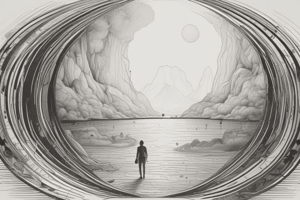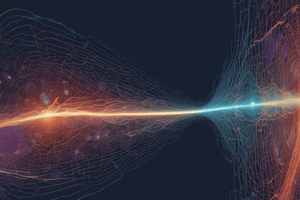Podcast
Questions and Answers
Which theory of perception emphasizes the role of top-down processing, where people actively construct their perceptions based on expectations and prior knowledge?
Which theory of perception emphasizes the role of top-down processing, where people actively construct their perceptions based on expectations and prior knowledge?
- Constructive perception theory (correct)
- Bottom-up processing theory
- Recognition-by-components theory
- Direct perception theory
According to the Ebbinghaus size illusion, how does the perception of the size of one object (the orange circle) get influenced by the size of another object (the black circles)?
According to the Ebbinghaus size illusion, how does the perception of the size of one object (the orange circle) get influenced by the size of another object (the black circles)?
- The orange circle appears larger when the black circles are smaller. (correct)
- The size of the black circles has no effect on the perceived size of the orange circle.
- The orange circle appears larger when the black circles are larger.
- The orange circle appears smaller when the black circles are larger.
What is the key difference between the direct perception theory and the constructive perception theory in terms of their focus?
What is the key difference between the direct perception theory and the constructive perception theory in terms of their focus?
- Direct perception theory focuses on the neural hierarchy processing increasingly complex stimuli, while constructive perception theory focuses on basing one perception on another.
- Direct perception theory focuses on top-down processing, while constructive perception theory focuses on bottom-up processing.
- Direct perception theory focuses on the role of context in perception, while constructive perception theory focuses on the role of expectations in perception.
- Direct perception theory focuses on identifying and combining elementary features, while constructive perception theory focuses on actively constructing perceptions. (correct)
Which of the following is an example of how top-down processing can influence perception, as discussed in the text?
Which of the following is an example of how top-down processing can influence perception, as discussed in the text?
What is the key insight from the recognition-by-components (RBC) theory proposed by Biederman?
What is the key insight from the recognition-by-components (RBC) theory proposed by Biederman?
Which of the following best describes the modern psychological perspective on the role of experience in perception?
Which of the following best describes the modern psychological perspective on the role of experience in perception?
Which of the following perceptual cues is NOT mentioned in the text as contributing to the perception of depth?
Which of the following perceptual cues is NOT mentioned in the text as contributing to the perception of depth?
What is the primary factor that determines the perceived size of an object?
What is the primary factor that determines the perceived size of an object?
Which of the following best describes the light-from-above heuristic?
Which of the following best describes the light-from-above heuristic?
Which of the following is an example of a semantic regularity governing perception?
Which of the following is an example of a semantic regularity governing perception?
Which principle of Gestalt psychology is most likely responsible for perceiving (a) as (b) and not as (c)?
Which principle of Gestalt psychology is most likely responsible for perceiving (a) as (b) and not as (c)?
What is the primary difference between bottom-up and top-down processing in perception, as described in the text?
What is the primary difference between bottom-up and top-down processing in perception, as described in the text?
What is the main message or conclusion that can be drawn from the text's discussion of bottom-up and top-down processing in perception?
What is the main message or conclusion that can be drawn from the text's discussion of bottom-up and top-down processing in perception?
What are the key heuristics used for efficient interpretation of ambiguous visual input?
What are the key heuristics used for efficient interpretation of ambiguous visual input?
According to the passage, what is the key difference between simple and complex cells in the striate cortex?
According to the passage, what is the key difference between simple and complex cells in the striate cortex?
What is the main point of the passage regarding the role of illusions in the study of visual perception?
What is the main point of the passage regarding the role of illusions in the study of visual perception?
How does the passage characterize the relationship between perception and the external world?
How does the passage characterize the relationship between perception and the external world?
Study Notes
Theories of Perception
- Constructive perception theory emphasizes top-down processing, where individuals actively shape perceptions using expectations and prior knowledge.
- Direct perception theory focuses on how sensory information directly leads to perception without the influence of past experiences.
Ebbinghaus Size Illusion
- The perception of an object's size, like an orange circle, is influenced by surrounding objects, such as black circles, altering the perceived size through contextual comparison.
Recognition-by-Components (RBC) Theory
- Proposed by Biederman, RBC theory suggests that objects are recognized by analyzing their basic three-dimensional components (geons) and their configurations.
Modern Psychological Perspective
- The contemporary view emphasizes the significant role of experience and context in shaping perception, recognizing that prior knowledge and expectations play a crucial role.
Depth Perception Cues
- Certain perceptual cues, like texture gradient or linear perspective, contribute to the perception of depth; others may not have been specifically mentioned.
Factors Determining Perceived Size
- The perceived size of an object is primarily determined by context, relative size, distance, and surrounding elements that influence visual interpretation.
Light-from-Above Heuristic
- The light-from-above heuristic is a perceptual assumption that visual scenes are illuminated from above, influencing how shadows are interpreted.
Semantic Regularities in Perception
- An example of semantic regularity involves recognizing familiar contexts or scenarios that inform how objects are perceived based on learned associations.
Gestalt Psychology Principles
- Gestalt principles, such as proximity or similarity, influence how we group and perceive objects, leading to distinct interpretations of visual data.
Bottom-Up vs. Top-Down Processing
- Bottom-up processing involves perception that starts with sensory input, while top-down processing relies on cognitive factors like context and expectations.
Main Message on Processing
- The discussion emphasizes the interplay between bottom-up and top-down processing in perception, illustrating how both processes work together to shape human experience.
Heuristics for Visual Input
- Key heuristics, like the principle of parsimony and other mental shortcuts, aid in interpreting ambiguous visual information efficiently.
Simple vs. Complex Cells
- Simple cells in the striate cortex respond to specific orientations and locations of stimuli while complex cells are more sensitive to motion and can respond to stimuli across a larger area.
Role of Illusions
- Illusions highlight the complexities and limitations of visual perception, demonstrating how the brain can misinterpret sensory information.
Perception and External World
- The relationship between perception and the external world is characterized by a dynamic interaction where perceptions are not merely reflections of the outside world but are influenced by cognitive processes and experiences.
Studying That Suits You
Use AI to generate personalized quizzes and flashcards to suit your learning preferences.
Related Documents
Description
Test your knowledge on different approaches to understanding perception, including direct perception theories and constructive perception theories that focus on bottom-up and top-down processing. Explore how stimuli in the environment contribute to recognition and how individuals construct perceptions using information.




